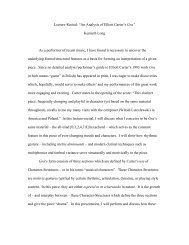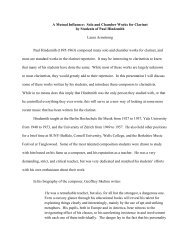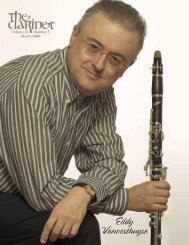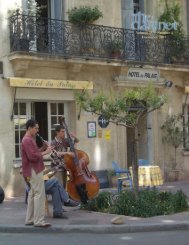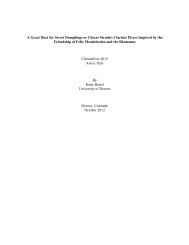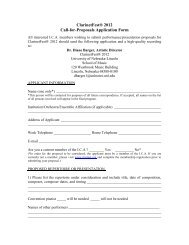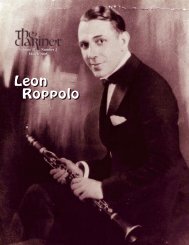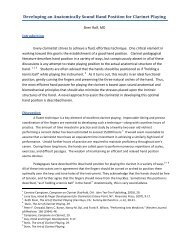A Study of Klezmer Performance Practice Issues in Osvaldo
A Study of Klezmer Performance Practice Issues in Osvaldo
A Study of Klezmer Performance Practice Issues in Osvaldo
Create successful ePaper yourself
Turn your PDF publications into a flip-book with our unique Google optimized e-Paper software.
A <strong>Study</strong> <strong>of</strong> <strong>Klezmer</strong> <strong>Performance</strong> <strong>Practice</strong> <strong>Issues</strong> <strong>in</strong> <strong>Osvaldo</strong> Golijov’s The Dreamsand Prayers <strong>of</strong> Isaac the Bl<strong>in</strong>d for <strong>Klezmer</strong> Clar<strong>in</strong>et and Str<strong>in</strong>g QuartetJoan BlazichThe music <strong>of</strong> <strong>Osvaldo</strong> Golijov (b.1960) displays his compositional depth andtalent across both genre and style. Golijov frequently uses elements <strong>of</strong> klezmer, Jewishmusic that is traditionally transmitted aurally and fulfills both religious and historicalpurposes, to provide his works with an unusual vitality. This fusion <strong>of</strong> klezmer andclassical music can be best seen <strong>in</strong> his The Dreams and Prayers <strong>of</strong> Isaac the Bl<strong>in</strong>d forklezmer clar<strong>in</strong>et and str<strong>in</strong>g quartet where traditional klezmer melodies are <strong>in</strong>tegrated <strong>in</strong>toa standard chamber music sett<strong>in</strong>g. The klezmer performance practice issues <strong>in</strong> this workare highly problematic however, due <strong>in</strong> part to their reliance on aural tradition. I proposeto analyze The Dreams and Prayers <strong>of</strong> Isaac the Bl<strong>in</strong>d by <strong>Osvaldo</strong> Golijov by focus<strong>in</strong>gon the use <strong>of</strong> klezmer throughout the piece. Specific emphasis will be placed onrecogniz<strong>in</strong>g klezmer harmonies, melodies, and rhythmic patterns. Ornamentation will bediscussed at length, <strong>in</strong>clud<strong>in</strong>g compar<strong>in</strong>g different performances <strong>of</strong> the same melodies.The production <strong>of</strong> special klezmer effects, such as the Sh<strong>of</strong>ar (ram’s horn) and Davenen(wordless prayer), will also be discussed.Golijov’s <strong>in</strong>terest <strong>in</strong> klezmer comes from his Jewish heritage. Life <strong>in</strong> Jewishcommunities <strong>in</strong> Argent<strong>in</strong>a, Israel, and now the United States has allowed Golijov toobserve various styles <strong>of</strong> klezmer performance and subsequently <strong>in</strong>corporate them <strong>in</strong>tohis own music: “I started writ<strong>in</strong>g the music I live with– music that from moment tomoment is as direct as folk music, but has an architecture that leaves you at a different
2place at the end.” 1 This blend<strong>in</strong>g <strong>of</strong> classical and klezmer <strong>in</strong> The Dreams and Prayers <strong>of</strong>Isaac the Bl<strong>in</strong>d spans five movements, and the title <strong>of</strong> the work refers to the Kabbalistprophet Isaac the Bl<strong>in</strong>d who dictated a manuscript that claims everyth<strong>in</strong>g <strong>in</strong> the universecomes from the comb<strong>in</strong><strong>in</strong>g <strong>of</strong> letters <strong>in</strong> the Hebrew alphabet. 2The work’s use <strong>of</strong> klezmer also creates a strong sense <strong>of</strong> Golijov’s Jewish identityby recreat<strong>in</strong>g the history <strong>of</strong> Judaism through several different klezmer passages fordifferent pitches <strong>of</strong> clar<strong>in</strong>et, giv<strong>in</strong>g each melodic section its own dist<strong>in</strong>ct sound, mood,and mean<strong>in</strong>g:The Dreams and Prayers <strong>of</strong> Isaac the Bl<strong>in</strong>d is a k<strong>in</strong>d <strong>of</strong> epic, a history <strong>of</strong> Judaism.It has Abraham, exile, and redemption. The movements sound like they are <strong>in</strong> three <strong>of</strong>the languages spoken <strong>in</strong> almost 6,000 years <strong>of</strong> Jewish history: the first <strong>in</strong> Aramaic;the second <strong>in</strong>Yiddish; and the third <strong>in</strong> Hebrew. I never wrote with this idea <strong>in</strong> m<strong>in</strong>d,and only understood it when the work was f<strong>in</strong>ished. But while I was compos<strong>in</strong>g thesecond movement, for example, my father would sit out on the deck with thenewspaper, the sports pages, and every once <strong>in</strong> a while he would shout, “There yougo! Another Yiddish chord!” 3Each klezmer section, while notated, shows only a basic melodic l<strong>in</strong>e and requires theclar<strong>in</strong>etist to embellish the music accord<strong>in</strong>gly, rais<strong>in</strong>g serious issues <strong>of</strong> klezmerperformance practice with regard to how each particular melody should be ornamented.The tradition <strong>of</strong> aural transmission has made the study <strong>of</strong> klezmer and itsperformance practices highly problematic. <strong>Klezmer</strong> melodies were typically learned fromother musicians and performances were rout<strong>in</strong>ely done from memory. Some EasternEuropean klezmer musicians, also known as klemorims, upon immigrat<strong>in</strong>g to the United1 Ken Smith, “<strong>Osvaldo</strong> Golijov: How <strong>Klezmer</strong> Revitalized a Form Started by Mozart and Createda Masterpiece,” Gramophone (September 2002): A3.2 <strong>Osvaldo</strong> Golijov, The Dreams and Prayers <strong>of</strong> Isaac the Bl<strong>in</strong>d (Kronos Quartet and DavidKrakauer, Nonesuch Records. N 79444–2. Compact Disc).3 Ibid.
3States published books <strong>of</strong> Jewish melodies to both aid <strong>in</strong> the teach<strong>in</strong>g <strong>of</strong> Jewish musicand pr<strong>of</strong>it from the grow<strong>in</strong>g popularity <strong>of</strong> klezmer. These music books, like NatKostakowsky’s International Hebrew Wedd<strong>in</strong>g Music (1916) 4 and Jack Kammen’sInternational Dance Folio (1924) 5 , taught both non-Jewish and American-born Jewishmusicians various klezmer melodies. These books did not teach performance practicethough, leav<strong>in</strong>g techniques such as embellishment to the discretion <strong>of</strong> the performer. Theloss <strong>of</strong> many klezmer traditions due to the devastat<strong>in</strong>g persecution <strong>of</strong> Eastern EuropeanJews dur<strong>in</strong>g the first half <strong>of</strong> the twentieth century has further compounded these issues.Although a number <strong>of</strong> sheet music books are now available for perform<strong>in</strong>gklezmer on the clar<strong>in</strong>et, these sources conta<strong>in</strong> vary<strong>in</strong>g amounts <strong>of</strong> performance<strong>in</strong>formation. Almost all <strong>of</strong> these books conta<strong>in</strong> transcriptions <strong>of</strong> melodies recorded mostlyby clar<strong>in</strong>etist and Jewish big band leader Dave Tarras. The <strong>Klezmer</strong> Repertoire forClar<strong>in</strong>et, vol.1 6 , by Mike Curtis, does not conta<strong>in</strong> any performance notes while EdwardHuws-Jones’s The <strong>Klezmer</strong> Clar<strong>in</strong>et: Jewish Music <strong>of</strong> Celebration <strong>of</strong>fers only scant<strong>in</strong>formation on each transcription and no assistance on how to ornament the music. 7 TheClar<strong>in</strong>etist’s Guide to <strong>Klezmer</strong>, by Tom Puwalski, discusses how to perform klezmer andplaces a strong emphasis on the need to study record<strong>in</strong>gs. 8 The best <strong>in</strong>structional source,4 Nat Kostakowsky, International Hebrew Wedd<strong>in</strong>g Music (Brooklyn, NY: N. Kostakowsky,1916; repr<strong>in</strong>t, The Ultimate <strong>Klezmer</strong>. Arranged by Joshua Horowitz (Ow<strong>in</strong>gs Mills, MD: Tara Productions,2001).5 Jack Kammen, Kammen International Dance Folio No.1: Big Collection <strong>of</strong> Carefully SelectedSongs and Dances Good for All Occasions (New York: J. and J. Kammen Music Co., 1924).1996).6 Mike Curtis, The <strong>Klezmer</strong> Repertoire for Clar<strong>in</strong>et, vol.1 (Rottenburg, Germany: Advance Music,Hawkes, 2001).7 Edward Huws–Jones, The <strong>Klezmer</strong> Clar<strong>in</strong>et: Jewish Music <strong>of</strong> Celebration (London: Boosey and8 Tom Pulwalski, The Clar<strong>in</strong>etist’s Guide to <strong>Klezmer</strong> (n.p., Zephyr Publish<strong>in</strong>g, 2001).
4Joel Rub<strong>in</strong>’s Mazltov! Jewish-American Wedd<strong>in</strong>g Music from the Repertoire <strong>of</strong> DaveTarras, presents clearly written <strong>in</strong>formation on klezmer performance, as well as musicalexamples. 9 Music books like these are useful <strong>in</strong> identify<strong>in</strong>g various types <strong>of</strong> klezmermelodies and for study<strong>in</strong>g harmony. Ornamentation, although it is <strong>in</strong>cluded <strong>in</strong> somescores, still requires the study <strong>of</strong> record<strong>in</strong>gs and live performances though. <strong>Klezmer</strong>musicians typically ornament their melodies through the use <strong>of</strong> glissandi, vibrato, trills,turns, and mordents, but s<strong>in</strong>ce such embellishments reflect <strong>in</strong>dividual preferences and arerarely notated, their transmission thus rema<strong>in</strong>s an aural one.The klezmer passages <strong>in</strong> The Dreams and Prayers <strong>of</strong> Isaac the Bl<strong>in</strong>d areremarkably similar to melodies found <strong>in</strong> the clar<strong>in</strong>et transcription books discussed above.Although the clar<strong>in</strong>et’s solo passages conta<strong>in</strong> a few ornaments <strong>in</strong> the form <strong>of</strong> grace notes,Golijov states <strong>in</strong> a performer’s note that the clar<strong>in</strong>etist must, <strong>in</strong> the true nature <strong>of</strong> klezmer,create their own ornaments. 10 Golijov further enhances his klezmer melodies andharmonies through the use <strong>of</strong> five different clar<strong>in</strong>ets <strong>in</strong>clud<strong>in</strong>g clar<strong>in</strong>et <strong>in</strong> A, Bb, and C,basset horn, and bass clar<strong>in</strong>et. The prom<strong>in</strong>ence <strong>of</strong> the clar<strong>in</strong>et recalls the <strong>in</strong>strument’spopularity <strong>in</strong> many klezmer record<strong>in</strong>gs, and its flexibility allows for the production <strong>of</strong>specific sounds unique to klezmer and Judaism, such as imitat<strong>in</strong>g the Sh<strong>of</strong>ar. Theaddition <strong>of</strong> embellishments <strong>in</strong> such sections must arise therefore from the recognition <strong>of</strong>the melody type, the underly<strong>in</strong>g harmony, and the traditional treatment <strong>of</strong> similar klezmermelodies on record<strong>in</strong>gs.9 Rub<strong>in</strong>, Mazltov! Jewish-American Wedd<strong>in</strong>g Music from the Repertoire <strong>of</strong> Dave Tarras (Ma<strong>in</strong>z,Germany: Schott Music, 1998).10 Golijov, The Dreams and Prayers <strong>of</strong> Isaac the Bl<strong>in</strong>d. Edited by Todd Palmer (Wien, Germany:Universal Edition, 2000).
5This lecture-recital will beg<strong>in</strong> with a brief biographical sketch <strong>of</strong> <strong>Osvaldo</strong> Golijovand his klezmer–<strong>in</strong>fluenced compositions. I will then briefly discuss the history <strong>of</strong>klezmer by focus<strong>in</strong>g its tradition <strong>of</strong> oral transmission, its religious and historicalimportance, its differences between Eastern Europe and the United States, and thegradual development <strong>of</strong> “Americanized klezmer.” This discussion <strong>of</strong> klezmer will also<strong>in</strong>clude a quick overview on current trends <strong>in</strong> klezmer <strong>in</strong>clud<strong>in</strong>g the grow<strong>in</strong>g popularity<strong>of</strong> fus<strong>in</strong>g klezmer with classical and popular music and the rise <strong>of</strong> modern klezmerensembles.The ma<strong>in</strong> focus <strong>of</strong> this lecture-recital will be on Golijov’s use <strong>of</strong> klezmer and itsresult<strong>in</strong>g performance practice issues <strong>in</strong> The Dreams and Prayers <strong>of</strong> Isaac the Bl<strong>in</strong>d.Specific klezmer melodies such as the Bulgar, Do<strong>in</strong>a, and Hora will be discussed atlength and supplemented with musical examples highlight<strong>in</strong>g various comb<strong>in</strong>ations <strong>of</strong>modal scales and types <strong>of</strong> ornamentation. The production <strong>of</strong> sound effects such as theSh<strong>of</strong>ar and Davenen and the different tone qualities and characteristics <strong>of</strong> the A, Bb, andC clar<strong>in</strong>et, basset horn, and bass clar<strong>in</strong>et will also be discussed. To conclude, I willdiscuss how the passages <strong>of</strong> clar<strong>in</strong>et klezmer <strong>in</strong> The Dreams and Prayers <strong>of</strong> Isaac theBl<strong>in</strong>d can be identified, performed, and understood. I will also comment on how theimprovisatory nature <strong>of</strong> klezmer allows the clar<strong>in</strong>etist to enjoy a certa<strong>in</strong> degree <strong>of</strong>freedom <strong>in</strong> play<strong>in</strong>g these sections <strong>of</strong> klezmer.
6BibliographyAbramovitch, Ilana and Sean Galv<strong>in</strong>, eds. Jews <strong>of</strong> Brooklyn. Hanover, NH: UniversityPress <strong>of</strong> New Hanover, 2002.Beregovskii, Moiseĭ. Jewish Instrumental Folkmusic: The Collections and Writ<strong>in</strong>gs <strong>of</strong>Moshe Beregoski. Translated and Edited by Mark Slob<strong>in</strong>, Robert A. Rothste<strong>in</strong>,and Michael Alpert. Annotations by Michael Alpert. Syracuse, NY: SyracuseUniversity Press, 2001.Broughton, Simon. L<strong>in</strong>er notes to The Rough Guide to <strong>Klezmer</strong>. London: World MusicNetwork, 2000. RGNET 1047. Compact Disc.Card, Patricia Pierce. “The Influence <strong>of</strong> <strong>Klezmer</strong> on Twentieth-Century Solo andChamber Concert Music for Clar<strong>in</strong>et: With Three Recitals <strong>of</strong> Selected Works byManevich, Debussy, Horovitz, Milhaud, Mart<strong>in</strong>o, Mozart, and Others.” DMAthesis, University <strong>of</strong> North Texas, 2002.Carl, Robert and Robert Kirz<strong>in</strong>ger. “Golijov: Yiddishbbuk, The Dreams and Prayers <strong>of</strong>Isaac the Bl<strong>in</strong>d, Last Round, Lullaby and Do<strong>in</strong>a.” Fanfare 26:2 (November–December 2002): 153–55.Curtis, Mike. The <strong>Klezmer</strong> Repertoire for Bb Clar<strong>in</strong>et, vol.1. Rottenburg, Germany:Advance Music, 1996.From Avenue A to the Great White Way: Yiddish and American Popular Songs 1914–1950. Legacy, 1914; reissued by Columbia, 2002. C2K 86323. Compact Disc.G<strong>in</strong>gras, Michèle. “<strong>Klezmer</strong> for Klar<strong>in</strong>etists: A Beg<strong>in</strong>ner’s Guide.” The Clar<strong>in</strong>et 31:2(March 2004): 64–67.________. <strong>Klezmer</strong>’s Greatest Hits. The C<strong>in</strong>c<strong>in</strong>nati <strong>Klezmer</strong> Project. C<strong>in</strong>c<strong>in</strong>nati, OH:Mastersound Productions Inc., 1998. Compact Disc.Golijov, <strong>Osvaldo</strong>. The Dreams and Prayers <strong>of</strong> Isaac the Bl<strong>in</strong>d. Edited by Todd Palmer.(Wien, Germany: Universal Editions, 2000).________. The Dreams and Prayers <strong>of</strong> Isaac the Bl<strong>in</strong>d. Kronos Quartet and DavidKrakauer. Nonesuch Records, 1997. N 79444–2. Compact Disc.Gruber, Ruth Ellen. Virtually Jewish: Re<strong>in</strong>vent<strong>in</strong>g Jewish Culture <strong>in</strong> Europe. Berkeley,CA: University <strong>of</strong> California Press, 2002.Huws–Jones, Edward, arr. The <strong>Klezmer</strong> Clar<strong>in</strong>et: Jewish Music <strong>of</strong> Celebration. London:Boosey and Hawkes, 2001.
7Kammen, Jack. Kammen International Dance Folio No.1: Big Collection <strong>of</strong> CarefullySelected Songs and Dances Good for All Occasions. New York: J. and J.Kammen Music Co., 1924.<strong>Klezmer</strong> Music: A Marriage <strong>of</strong> Heaven and Earth. Roslyn, NY: Ellipsis Arts, 1996.Kostakowsky. Nat. International Hebrew Wedd<strong>in</strong>g Music. Brooklyn, NY: N.Kostakowsky, 1916; repr<strong>in</strong>t, The Ultimate <strong>Klezmer</strong>, arranged by Joshua Horowitz.Ow<strong>in</strong>gs Mills, MD: Tara Productions, 2001.Lornell, Kip. Introduc<strong>in</strong>g American Folkmusic: Ethnic and Grassroot Traditions <strong>in</strong> theUnited States. Boston: McGraw–Hill, 2002.________ and Anne K. Rasmussen, eds. Musics <strong>of</strong> Multicultural America: A <strong>Study</strong> <strong>of</strong>Twelve Musical Communities. New York: Schirmer Books, 1997.Mosteller, Sandra Marie. “ “Jewishness” <strong>in</strong> Selected Repertoire: A Resource for Clar<strong>in</strong>etMusic.” DMA thesis, The University <strong>of</strong> North Carol<strong>in</strong>a at Greensboro, 2001.Perlman, Itzhak. Tradition. Dov Seltzer, conductor. Israel Philharmonic Orchestra. EMIClassics, 2003. Compact Disc.Peylet, Nano and Denis Cuniot. Music <strong>of</strong> the Klezmorim. Paris: Buda Musique, 1989.SDRM 92567-2. Compact Disc.Puwalski, Tom. The Clar<strong>in</strong>etist’s Guide to <strong>Klezmer</strong>. n.p.: Zephyr Publish<strong>in</strong>g, 2001.Rogovoy, Seth. The Essential <strong>Klezmer</strong>: A Music Lover’s Guide to Jewish Roots and SoulMusic, from the Old World to the Jazz Age to the Downtown Avant-garde. ChapelHill, NC: Algongu<strong>in</strong> Books <strong>of</strong> Chapel Hill, 2000.Rub<strong>in</strong>, Joel. “The Clar<strong>in</strong>et <strong>in</strong> <strong>Klezmer</strong> Music.” The Clar<strong>in</strong>et 18:3 (May–June 1991): 32–37.________, ed. Mazltov! Jewish-American Wedd<strong>in</strong>g Music from the Repertoire <strong>of</strong> DaveTarras. Ma<strong>in</strong>z, Germany: Schott Music, 1998.Sapoznik, Henry. <strong>Klezmer</strong>! Jewish Music from the Old World to Our World. New York:Schirmer Books, 1999.________. The Compleat <strong>Klezmer</strong>. Transcriptions and Technical Introduction by PeteSokolow. Cedarhurst, NY: Tara Publications, 1987.________ and Shulamis Dion. The <strong>Klezmer</strong> Plus! Folio. Transcriptions andArrangements by Peter Sokolow. Cedarhurst, NY: Tara Publications, 1991.
8Seroussi, Edw<strong>in</strong>. “Jewish Music.” Grove Music Onl<strong>in</strong>e. Edited by L. Macy. (Accessed 10January 2010), http://www.grovemusic.com.Schwartz, Abe. The <strong>Klezmer</strong> K<strong>in</strong>g. Song Music Studios, 2002. CK 86321. Compact Disc.Shiloah, Amnon, ed. The <strong>Performance</strong> <strong>of</strong> Jewish and Arab Music <strong>in</strong> Israel Today.Amsterdam: Harwood Academic Publishers, 1997.Slob<strong>in</strong>, Mark. Fiddler on the Move: Explor<strong>in</strong>g the <strong>Klezmer</strong> World. Oxford, NY: OxfordUniversity Press, 2000.________, ed. American <strong>Klezmer</strong>: Its Roots and Offshoots. Berkeley, CA: University <strong>of</strong>California Press, 2002.Smith, Ken. “<strong>Osvaldo</strong> Golijov: How <strong>Klezmer</strong> Revitalized a Form Started by Mozart andCreated a Masterpiece.” Gramophone 80:957 (September 2002): A3, A6.Statman, Andy and David Grisman. Songs <strong>of</strong> Our Fathers: Traditional Jewish Melodies.San Rafael, CA: Acoustic Disc, 1995. ACD-14. Compact Disc.Strom, Yale. The Book <strong>of</strong> <strong>Klezmer</strong>: The History, The Music, The Folklore. Chicago: ACappella Books, 2002.Tarras, Dave. Yiddish–American <strong>Klezmer</strong> Music, 1925–1956. Yazoo Music,1992. Yazoo7001. Compact Disc.________ and The Musiker Brothers. Tanz! Sony Music Studios, 2001. CK 86320.Compact Disc.




